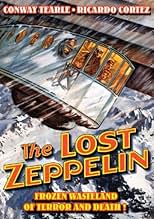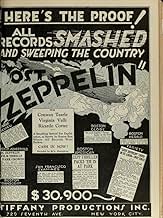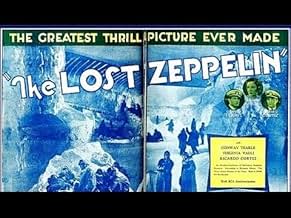Right before embarking on his South Pole mission Commander Hall hears his wife's confession that she loves his co-explorer Tom. Hall remains silent, they crash their zeppelin and only one of... Read allRight before embarking on his South Pole mission Commander Hall hears his wife's confession that she loves his co-explorer Tom. Hall remains silent, they crash their zeppelin and only one of the two can be picked up by the rescue plane.Right before embarking on his South Pole mission Commander Hall hears his wife's confession that she loves his co-explorer Tom. Hall remains silent, they crash their zeppelin and only one of the two can be picked up by the rescue plane.
- Director
- Writers
- Stars
- Director
- Writers
- All cast & crew
- Production, box office & more at IMDbPro
Featured reviews
THE STORY & GENRE -- This is an adventure tale, not genre, but we're reviewing because it's in the ASHSFF book under "Tangential", probably for the quality of special effects, which is quite high, rather than for any fantastical machinery. Good drama subplots.
THE VERDICT -- Even with primitive sound quality, and a bit of stiff acting, this is quite the accomplishment. As well as technically sound, the story-line is interesting and I did not find it unbelievable, as some others have.
FREE ONLINE -- Yes. Full 72 minutes.
THE VERDICT -- Even with primitive sound quality, and a bit of stiff acting, this is quite the accomplishment. As well as technically sound, the story-line is interesting and I did not find it unbelievable, as some others have.
FREE ONLINE -- Yes. Full 72 minutes.
"The Lost Zeppelin" is a fascinating story when you think about it. Although the sound effects are a bit crude (such as the droning engines), the sound quality is actually very, very good for 1929. Silents were on their way out, but the quality of sound was still very poor and the fact that you can actually clearly hear the dialog is a major plus--this is NOT the case today when you see many 1929 flicks (such as "Coquette"--an Oscar-winner but with horrible sound). It also has awfully nice special effects for 1929. While today they could do much better, for 1929 it was nice.
Unfortunately, while the film has its technical merits, the story itself is only fair. Part of the problem is the subplot involving the unfaithful wife and the captain--it just didn't make any sense--especially his reaction when he caught her with one of his officers. The other problem is that despite being an action story, it's all rather slow and dull. It's not terrible...it's just not all that good. In many ways, the film is highly reminiscent of the Leni Reifenstahl film, "S.O.S. Iceberg"--a film that debuted several years after "The Lost Zeppelin"--and I am pretty sure the Reifenstahl film was inspired by "The Lost Zeppelin".
Unfortunately, while the film has its technical merits, the story itself is only fair. Part of the problem is the subplot involving the unfaithful wife and the captain--it just didn't make any sense--especially his reaction when he caught her with one of his officers. The other problem is that despite being an action story, it's all rather slow and dull. It's not terrible...it's just not all that good. In many ways, the film is highly reminiscent of the Leni Reifenstahl film, "S.O.S. Iceberg"--a film that debuted several years after "The Lost Zeppelin"--and I am pretty sure the Reifenstahl film was inspired by "The Lost Zeppelin".
Conway Tearle is the stiff-upper lipped commander of a dirigible expedition that sets off on an arduous trip knowing that the wife he leaves behind "Miriam" (Virginia Valli) is in love with one of his colleagues "Tom" (Ricardo Cortez) and wants a divorce! Hardly an happy basis to start such a perilous mission, and when the winds and currents drive them to the frozen Antarctic their goose looks well and truly cooked (or frozen!). Can they survive these hostile climes long enough for rescue planes to arrive? Though there is some aerial photography, the vast majority of this story is relayed to us via his wife listening to updates on the radio, and after a while I found that quite dull. The audio tries far too hard to compensate for the visual wintry conditions - that are clearly studio set-bound, and the stilted acting - especially from a shockingly poor Valli really does spoil the adventure elements that I thought this might include. It's worth remembering that this was made when talkies were in their infancy, so I ought not to be too critical, but there is just too much melodrama and nowhere near enough adventure here and it's just not very good.
That this exsists at all is probably a minor miracle. Legend has it that David Selznick purchased all of the Tiffany-Stahl studio's negatives to utilize for the burning of Atlanta sequence in Gone With The Wind. Extant prints of films from this studio are rare, indeed. That aside, The Lost Zeppelin shows that the little studio was indeed trying to be up-to-date in marketing all-talking pictures. The dialouge delivery in the first section of the picture, before we get to the meat of the story, hearkens back to The Lights of New York (1928). Pregnant pauses and actors unsure about how to properly deliver dialouge are apparent. When the story gets to the dirigible party and their problems, the pace picks up and there are some pretty neat (for their time) effects. The studio must be praised for putting forth a story that is at once novel and original. This was released at Christmastime 1929 and it seems to have been successful in some quarters. In it's premiere in St.Louis, for example, the ads reported a take of $30,900 for the Christmas weekend. Pocket change today, but we must remember the time in which it was released. Conway Tearle and Virginia Valli are the top-billed players. The opening credits proclaim that this was "Synchronized by RCA Photophone". The print on the Alpha DVD was acceptably clear. In all, a film which will probably appeal to those who enjoy the early talkies. There are plenty of 20s fashions, hairdos and a huge radio in the living room of the heroine. Radio, in fact, is utilized throughout the film as a way to chart the progress of the Zeppelin. The Zeppelin itself is neatly represented by stock footage and the use of some neat miniatures. This is not an expensive film to buy and will be entertaining to those who enjoy film history.
I struggled to stay with this film to see it to the end. I give it two stars just for a try at a plot. Besides some very good silent films of the 1920s, I've rated about a dozen talkies of 1929 from 7 to 10 stars. Those were all produced by Paramount, MGM, Warner Brothers and a British studio.
"The Lost Zeppelin" was made by one of the 80 or so poverty row studios that existed in the early years of movie making. Tiffany-Stahl lasted longer than most, from 1921 to 1931, and turned out 70 films in that time. This was one of its last. And this film is a good example of why it and the host of poverty row studios didn't last. The few good directors and technicians that started in the lower echelons eventually made it into the big studios or went with a successful independent that would later make it big or merge into one of the other studios.
Normally, I wouldn't bother to review a film I rate so low. But since this is now out on DVD, I thought prospective viewers might like more comment than has been posted on IMDb to this time. I won't urge folks not to watch this – but you should know what to expect before you plunk down cash to buy or rent it. Indeed, I had some inkling of what it was about, but I wanted to see it for myself. And, I'm glad I did – because I now know what the very cheap poverty row films were like.
Everything about this film is poor, with the possible exception of the sound from the dialog. The sets are very amateurish and poor – such as an airplane door that slides open. No kidding – just like a sliding door in a house. Then, when a crew person opens the door, it starts to fall out of its track and he shoves it back. The airplane engine noise is some strange irritating sound created by sound effects, and doesn't sound anything like a plane engine. The film quality itself is barely watchable. The script is something that a third-grade student might create today. But the directing and acting are the very worst.
Conway Tearle and Ricardo Cortez had small movie careers through the 1930s. But those were mostly in B films. The rest of the cast are actors who couldn't make the transition from silent to sound. Virginia Valli had made more than 60 films in the silent era; but after this, she made only two more before retiring from films at age 35. That's when many of the best actors begin to shine. The acting is very hammy in this, and one can see long pauses and long glances at the camera – techniques used in the silent films to allow subtitles to show. While the voices of all this cast were OK, they apparently couldn't transition to real acting. There were many silent film stars who didn't succeed in sound films because their unusual voices didn't fit their images in the minds of the movie-going public.
So, this isn't likely to be very entertaining; but if you want to see an example of the hundreds and even thousands of early films that aren't around anymore – and of the type of films put out by the short-lived and over-night cheap studios, then you may enjoy watching "The Lost Zeppelin."
I found this bit of trivia that movie buffs might enjoy. Apparently, MGM bought Tiffany's original film library and used it for fuel in "Gone with the Wind." It went up in flames in the scene of the burning of Atlanta. I doubt if it was very expensive kindling.
"The Lost Zeppelin" was made by one of the 80 or so poverty row studios that existed in the early years of movie making. Tiffany-Stahl lasted longer than most, from 1921 to 1931, and turned out 70 films in that time. This was one of its last. And this film is a good example of why it and the host of poverty row studios didn't last. The few good directors and technicians that started in the lower echelons eventually made it into the big studios or went with a successful independent that would later make it big or merge into one of the other studios.
Normally, I wouldn't bother to review a film I rate so low. But since this is now out on DVD, I thought prospective viewers might like more comment than has been posted on IMDb to this time. I won't urge folks not to watch this – but you should know what to expect before you plunk down cash to buy or rent it. Indeed, I had some inkling of what it was about, but I wanted to see it for myself. And, I'm glad I did – because I now know what the very cheap poverty row films were like.
Everything about this film is poor, with the possible exception of the sound from the dialog. The sets are very amateurish and poor – such as an airplane door that slides open. No kidding – just like a sliding door in a house. Then, when a crew person opens the door, it starts to fall out of its track and he shoves it back. The airplane engine noise is some strange irritating sound created by sound effects, and doesn't sound anything like a plane engine. The film quality itself is barely watchable. The script is something that a third-grade student might create today. But the directing and acting are the very worst.
Conway Tearle and Ricardo Cortez had small movie careers through the 1930s. But those were mostly in B films. The rest of the cast are actors who couldn't make the transition from silent to sound. Virginia Valli had made more than 60 films in the silent era; but after this, she made only two more before retiring from films at age 35. That's when many of the best actors begin to shine. The acting is very hammy in this, and one can see long pauses and long glances at the camera – techniques used in the silent films to allow subtitles to show. While the voices of all this cast were OK, they apparently couldn't transition to real acting. There were many silent film stars who didn't succeed in sound films because their unusual voices didn't fit their images in the minds of the movie-going public.
So, this isn't likely to be very entertaining; but if you want to see an example of the hundreds and even thousands of early films that aren't around anymore – and of the type of films put out by the short-lived and over-night cheap studios, then you may enjoy watching "The Lost Zeppelin."
I found this bit of trivia that movie buffs might enjoy. Apparently, MGM bought Tiffany's original film library and used it for fuel in "Gone with the Wind." It went up in flames in the scene of the burning of Atlanta. I doubt if it was very expensive kindling.
Did you know
- TriviaThis film, like Le Dirigeable (1931), is also loosely based on the crash of the airship "Italia", flown by Umberto Nobile, around 5/25/1928, near the North Pole, and the international rescue effort that cost early polar explorer Roald Amundsen his life. The pilot who rescued Nobile also crashed when returning to rescue more survivors and had to be rescued himself.
- GoofsThe news broadcast heard by Miriam Hall and her house guests announces a cable has arrived from the dirigible sent on August 4 at 4:22 p.m. Eastern Standard Time. That date was in the middle of summer and would have been during Daylight Savings Time, which in 1929 began on in April and ended in late September.
Details
- Release date
- Country of origin
- Language
- Also known as
- Den försvunna zeppelinaren
- Filming locations
- Production company
- See more company credits at IMDbPro
- Runtime
- 1h 12m(72 min)
- Color
- Aspect ratio
- 1.20 : 1
Contribute to this page
Suggest an edit or add missing content























